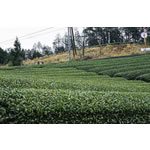Home > Teach me Tea Cha! > Cultivars > Okumidori
Main content starts here.
Okumidori
Okumidori: Combine with "Yabukita" to extend the harvesting period


Processing characteristics
“Okumidori” is a late-maturity cultivar with a sprouting period beginning 11 days later than “Yabukita” and a leaf picking period being 8 days later than “Yabukita”.
Its sprouts harden slowly, grow well and have a high yield. The quality of the produced tea is excellent, it is easy the appearance to be translucent, the color and luster is dark green, the flavor is refreshing and clean. Although it does not possess a particularly unique quality, it is an easy-to-use cultivar with no drawbacks or strong characteristics.
Notes on cultivation
The “Okumidori” tree is strong and the shape is upright. It is suitable for mountainous areas and frost-prone areas because it is late-maturity cultivar and therefore is resistant to cold. “Okumidori” is vulnerable to anthrax and requires control in areas where it is likely to occur. No other damages can be expected by noticeable pests.
Notes on processing
Tea processing is not particularly difficult for this cultivar. If picking is done too late in the season, the stems would stand out. Taking advantage of the fresh aroma can bring out its fine characteristics of the cultivar.
Dissemination and land suitability for cultivation
Although it is not a recommended cultivar within Shizuoka Prefecture, it is cultivated on 35.0 ha within the prefecture.
The cases are introduced such as that the Sencha production area in Kyoto Prefecture and Kabuse tea production area in Mie Prefecture used a combination of medium-maturity “Yabukita” and late-maturity “Okumidori” to expand the harvesting period and disperse labor, as an example of how to improve quality and stabilize management by 1999. In Mie Prefecture, the cultivation area has been growing rapidly in recent years. The area is highly regarded for Tencha, a crude tea for matcha in Aichi and for Gyokuro in Fukuoka. In Saga Prefecture, it is attracting attention as a late-maturity cultivar for cultivar combinations.
The area under cultivation is growing in Miyazaki and Kagoshima prefectures. In these prefectures, due to the expanded scale, “Yabukita” is no longer sufficient to meet demand, “Okumidori” was introduced to diversify the harvesting period by 1999.
